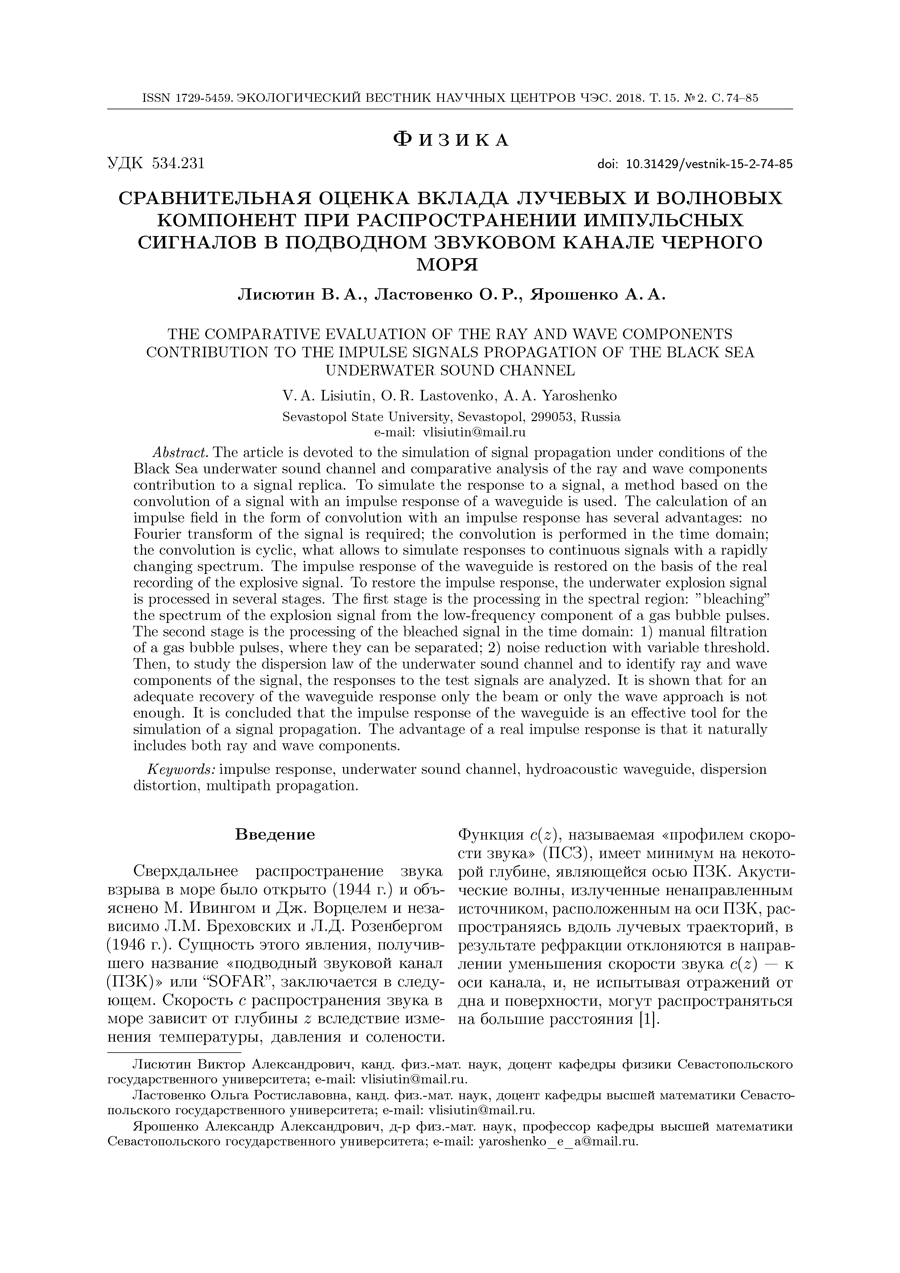The comparative evaluation of the ray and wave components contribution to the impulse signals propagation of the Black Sea underwater sound channel
UDC
534.231DOI:
https://doi.org/10.31429/vestnik-15-2-74-85Abstract
The article is devoted to the simulation of signal propagation under conditions of the Black Sea underwater sound channel and comparative analysis of the ray and wave components contribution to a signal replica. To simulate the response to a signal, a method based on the convolution of a signal with an impulse response of a waveguide is used. The calculation of an impulse field in the form of convolution with an impulse response has several advantages: no Fourier transform of the signal is required; the convolution is performed in the time domain; the convolution is cyclic, what allows to simulate responses to continuous signals with a rapidly changing spectrum.
The impulse response of the waveguide is restored on the basis of the real recording of the explosive signal. To restore the impulse response, the underwater explosion signal is processed in several stages. The first stage is the processing in the spectral region: "bleaching" the spectrum of the explosion signal from the low-frequency component of a gas bubble pulses. The second stage is the processing of the bleached signal in the time domain: 1) manual filtration of a gas bubble pulses, where they can be separated; 2) noise reduction with variable threshold. Then, to study the dispersion law of the underwater sound channel and to identify ray and wave components of the signal, the responses to the test signals are analyzed. It is shown that for an adequate recovery of the waveguide response only the beam or only the wave approach is not enough. It is concluded that the impulse response of the waveguide is an effective tool for the simulation of a signal propagation. The advantage of a real impulse response is that it naturally includes both ray and wave components.
Keywords:
impulse response, underwater sound channel, hydroacoustic waveguide, dispersion distortion, multipath propagationReferences
- Vadov, R.A. The discovery of the underwater sound channel, experimental studies, and regional differences. Acoust. Phys., 2007, vol. 53, no. 3, p. 268-281.
- Bezotvetnykh, V.V., Burenin, A.V., Morgunov, Yu.N., Tagil'tsev, A.A. Processing of acoustic signals and computer modeling instrumental and programming measuring complex for acoustic navigation investigations. Acoust. Phys., 2011, vol. 57, no. 3, pp. 819-823.
- Morgunov, Yu.N., Bezotvetnykh, V.V., Burenin, A.V., Voitenko, E.A. A study of how hydrological conditions affect the propagation of pseudorandom signals from the shelf in deep water. Acoust. Phys., 2016, vol. 62, no. 3, pp. 350-356.
- Jensen, F.B., Kuperman, W.A., Porter, M.B., Schmidt, H. Computational ocean acoustics. Springer Science$+$Business Media, LLC 2011.
- Lastovenko, O.R., Lisyutin, V.A., Yaroshenko, A.A. Modeling of signal propagation in refractive waveguides of the shallow sea. Rep. of the 13th School-Sem. Acad. L.M. Brekhovskikh "Acoustics of the Ocean", combined with the 23th session of the Russian Acoustical Society. Moscow, 2011, pp. 74-77. (In Russian)
- Vadov, R.A. On some hydroacoustic characteristics of an explosive signal. Akusticheskiy zhurnal [Acoustic journal], 1994, vol. 40. no. 4, pp. 677-679. (In Russian)
- Vadov, R.A. Peculiarities in the formation of the sound field structure of a point source in the Black Sea underwater sound channel. Acoust. Phys., 2011, vol. 57, no. 5, pp. 642-651.
- Vadov, R.A. Structure of the sound field generated by a point source in the underwater sound channel of the Black Sea. Acoust. Phys., 1998, vol. 44, no. 5, pp. 651-658.
- Interdisciplinary information and consulting system on modern areas of acoustics. Access mode: http:/spravka.akin.ru (accessed date 20.12.2017). (In Russian)
- Brekhovskikh, L.M., Lysanov, Yu.P. Fundamentals of ocean acoustics. Springer, 2003.
- Brekhovskikh, L.M. Waves in layered media. Elsevier, 2nd Edition.
- Studenichnik, N.V. Space-Time Structure of the low-frequency acoustic field in an underwater sound channel. Acoust. Phys., 2002, vol. 48, no. 5, pp. 598-606.
- Chapman, N.R. Measurement of the waveform parameters of shallow explosive chargers. J. Acoust. Soc. Am., 1985, vol. 78, no. 2, pp. 672-681.
- Soloway, A.G., Dahl, P.H. Peak sound pressure and exposure level from underwater explosions in shallow water. J. Acoust. Soc. Am., 2014, vol. 136, no 3, pp. EL218-EL223.
- Vadov, R.A. Temporal variability of the fine structure of a signal in the ocean. Acoust. Phys., 1996, vol. 42, no. 4, pp. 430-435.
- Sergienko, A.B. Digital signal processing. St. Petersburg, 2002. (In Russian)
Downloads
Submitted
Published
How to Cite
Copyright (c) 2018 Lisiutin V.A., Lastovenko O.R., Yaroshenko A.A.

This work is licensed under a Creative Commons Attribution 4.0 International License.




